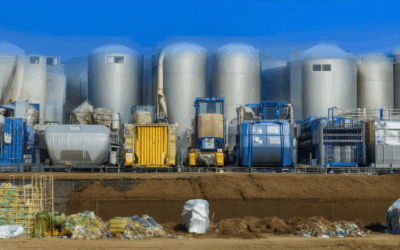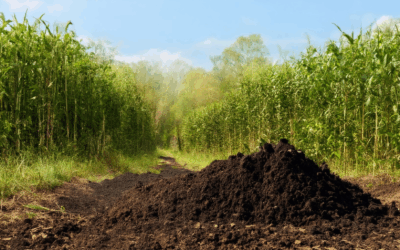Resource-conserving farming represents a transformative approach to modern agriculture, blending efficiency with environmental stewardship. In today’s increasingly eco-conscious world, practices that prioritize resource preservation are not just beneficial—they’re essential. By focusing on sustainable land management and innovative agricultural techniques, resource-conserving farming offers a pathway to healthier ecosystems, reduced environmental impact, and long-term agricultural productivity. This approach emphasizes the careful use of resources such as water, soil, and energy, ensuring that farming remains viable for future generations while minimizing its ecological footprint. As global demand for eco-friendly solutions grows, resource-conserving farming stands out as a cornerstone of sustainable practices, offering practical strategies for farmers and policymakers alike. From reducing chemical use to enhancing soil health, the principles of resource-conserving farming are reshaping the way we think about food production and environmental responsibility. Join us as we explore the key principles, practices, and real-world applications of this vital movement in agriculture.
Key Takeaways
– Boost agricultural productivity by integrating agroforestry practices to enhance soil health and biodiversity.
– Sustain soil fertility through crop rotation and reduced tillage to minimize environmental impact and improve long-term yields.
– Conserve water resources using drip irrigation and rainwater harvesting systems to optimize water usage.
– Protect ecosystems by implementing integrated pest management (IPM) and cover cropping to reduce reliance on synthetic pesticides.
– Optimize resource use with precision agriculture tools and organic amendments to enhance soil health and reduce input costs.
– Strengthen resilience by incorporating agroforestry and terraced farming to stabilize soil and improve air quality.
– Reduce environmental footprint through sustainable livestock practices and carbon-sequestering soils for climate mitigation.
These strategies ensure eco-friendly farming practices that benefit both the environment and agricultural productivity.

What is Resource-Conserving Farming and Why is It Important?
Resource-conserving farming is an agricultural practice focused on optimizing the use of natural resources such as water, fertilizers, and energy to enhance productivity while minimizing environmental impact. This approach aligns with sustainable farming principles, aiming to preserve soil health, reduce waste, and promote biodiversity.
Key Practices of Resource-Conserving Farming
- Crop Rotation and Inter cropping: Rotating crops helps maintain soil fertility and reduces the need for synthetic fertilizers. Intercropping, planting two or more crops together, maximizes resource use and improves pest control.
- Water Efficiency: Techniques like drip irrigation and rainwater harvesting reduce water consumption, making farming more resilient to droughts and water scarcity.
- Sustainable Fertilizer Use: Utilizing organic amendments like compost and biochar enhances soil structure and nutrient availability, reducing reliance on chemical fertilizers.
- Agroforestry: Integrating trees with crops improves soil health, provides shade for plants, and acts as a carbon sink, contributing to climate regulation.
- Precision Agriculture: Using technology like sensors and GPS ensures resources are used efficiently by monitoring soil conditions and optimizing planting and irrigation.
Importance of Resource-Conserving Farming
- Environmental Sustainability: Reduces greenhouse gas emissions, conserves water, and prevents soil erosion, supporting ecosystem balance.
- Food Security: Enhances productivity with fewer resources, ensuring stable food supplies despite climate changes and resource limitations.
- Economic Viability: Lowers input costs and increases farm profitability, while meeting consumer demand for sustainably produced goods.
- Biodiversity Support: Promotes wildlife habitats and contributes to pollinator health, essential for sustainable agriculture.
Challenges and Solutions
Adopting resource-conserving farming requires investment in new technologies and training. However, governments, NGOs, and farmers can collaborate to address barriers through subsidies, education, and community networks.
Conclusion
Resource-conserving farming is a vital strategy for achieving global food security and environmental sustainability. By embracing efficient practices, farmers can thrive economically while playing a key role in combating climate change and preserving natural resources for future generations.
How Does Resource-Conserving Farming Reduce Environmental Impact?
Resource-conserving farming is a sustainable agricultural practice focused on optimizing resource use while minimizing environmental degradation. Here’s how it helps reduce the environmental footprint:
- Crop Rotation
- Reduces reliance on synthetic fertilizers and pesticides.
- Preserves soil health and prevents nutrient depletion.
- Minimizes soil erosion and enhances biodiversity.
- Agroforestry
- Integrates trees with crops and livestock.
- Improves soil structure and water retention.
- Enhances carbon sequestration and biodiversity.
- Conservation Tillage
- Leaves crop residues on the surface to protect soil.
- Reduces soil erosion and improves organic matter.
- Decreases fuel consumption for tillage operations.
- Reduced Chemical Inputs
- Minimizes the use of synthetic pesticides and herbicides.
- Protects water quality and local wildlife habitats.
- Reduces contamination risks to air, water, and soil.
- Water Conservation
- Uses drip irrigation and rainwater harvesting systems.
- Improves water efficiency and reduces runoff.
- Preserves groundwater levels and supports aquatic ecosystems.
- Integrated Pest Management
- Combines crop rotation, companion planting, and biological controls.
- Reduces reliance on chemical pesticides.
- Supports beneficial insects and promotes biodiversity.
By adopting these practices, resource-conserving farming not only enhances environmental sustainability but also promotes long-term agricultural productivity. It aligns with global efforts to combat climate change, conserve biodiversity, and promote sustainable development.
For more insights into sustainable farming practices, visit our Pyrolysium website and explore our comprehensive guides on eco-friendly agriculture and sustainable living.

Key Principles of Resource-Conserving Farming
Resource-conserving farming focuses on optimizing agricultural practices to enhance productivity while minimizing environmental impact. Here are the core principles:
- Agroforestry : Integrating trees and crops to improve soil health, reduce erosion, and increase biodiversity.
- Crop Rotation : Planting different crops sequentially to maintain soil fertility and break pest cycles.
- Water Conservation : Implementing techniques like drip irrigation and rainwater harvesting to minimize water usage.
- Integrated Pest Management : Using organic methods, biological controls, and crop rotation to manage pests effectively.
- Soil Health Optimization : Regularly adding organic matter, avoiding chemical fertilizers, and reducing tillage to preserve soil structure.
By adopting these practices, farmers can improve yields, protect ecosystems, and promote long-term agricultural sustainability. Visit our website to learn more about sustainable farming techniques and how you can contribute to this important cause.

Key Principles of Resource-Conserving Farming
Resource-conserving farming focuses on optimizing agricultural practices to enhance productivity while minimizing environmental impact. Here are the core principles:
- Agroforestry : Integrating trees and crops to improve soil health, reduce erosion, and increase biodiversity.
- Crop Rotation : Planting different crops sequentially to maintain soil fertility and break pest cycles.
- Water Conservation : Implementing techniques like drip irrigation and rainwater harvesting to minimize water usage.
- Integrated Pest Management : Using organic methods, biological controls, and crop rotation to manage pests effectively.
- Soil Health Optimization : Regularly adding organic matter, avoiding chemical fertilizers, and reducing tillage to preserve soil structure.
By adopting these practices, farmers can improve yields, protect ecosystems, and promote long-term agricultural sustainability. Visit our website to learn more about sustainable farming techniques and how you can contribute to this important cause.
Key Practices of Resource-Conserving Farming
Resource-conserving farming emphasizes efficiency and sustainability to minimize environmental impact while maximizing productivity. Here are the primary practices:
- Crop Rotation : Rotate crops to maintain soil health and reduce reliance on synthetic fertilizers. This practice prevents soil degradation and enhances biodiversity.
- Cover Cropping : Plant cover crops during off-seasons to protect soil, suppress weeds, and improve water retention. These crops, like clover or rye, act as a green manure to enrich the soil.
- Precision Agriculture : Use technology and data-driven techniques to optimize resource use. Sensors and GPS-guided equipment help apply inputs precisely, reducing waste and environmental impact.
- Agroforestry : Integrate trees and shrubs into farming systems to provide shade, stabilize soil, and improve air quality. This method enhances biodiversity and reduces erosion.
- Integrated Pest Management (IPM) : Employ biological, chemical, and cultural methods to control pests. IPM reduces reliance on harmful pesticides and promotes sustainable pest control.
- Soil Conservation : Implement practices like contour plowing and terracing to prevent soil erosion. Healthy soils retain water and nutrients, making farms more resilient.
- Water Conservation : Use drip irrigation and rainwater harvesting systems to efficiently manage water resources. This reduces demand on freshwater supplies.
- Reduced Tillage : Minimize tillage operations to preserve soil structure and organic matter. Less tillage also reduces fuel consumption and greenhouse gas emissions.
- Organic Amendments : Apply compost and manure to enhance soil fertility without synthetic chemicals. This supports microbial activity and long-term soil health.
- Sustainable Livestock Practices : Keep livestock numbers manageable to avoid overgrazing. Proper animal husbandry ensures efficient resource use and reduces environmental stress on the land.
By adopting these practices, farmers can create more resilient ecosystems while producing food sustainably. Visit Pyrolysium to learn more about sustainable farming techniques and innovations.

Key Principles of Resource-Conserving Farming
Resource-conserving farming focuses on optimizing agricultural practices to minimize environmental impact while maximizing productivity. Here are the core principles:
- Soil Health Preservation : Healthy soil supports robust crop growth and reduces the need for synthetic fertilizers. Techniques include crop rotation, cover cropping, and organic amendments.
- Water Efficiency : Implement drip irrigation systems and rainwater harvesting to conserve water. Efficient irrigation reduces waste and ensures optimal moisture levels for plants.
- Integrated Pest Management : Use biological controls, crop rotation, and natural predators to manage pests instead of chemical pesticides. This maintains biodiversity and reduces long-term costs.
- Agroforestry : Incorporate trees and shrubs into farm layouts to provide shade, erosion control, and nutrient-rich additions to the soil. This enhances ecosystem health.
- Reduced Tillage : Minimize plowing to prevent soil erosion and retain organic matter. Conservation tillage improves soil structure and carbon sequestration.
- Organic and Local Inputs : Prioritize organic seeds, compost, and locally sourced materials to reduce reliance on industrial inputs and support local economies.
- Carbon Sequestration : Farms with healthy soils and diverse ecosystems can store significant amounts of carbon, helping mitigate climate change effects.
These principles ensure that farming operations are sustainable and leave a smaller ecological footprint. By adopting resource-conserving practices, farmers contribute to a healthier planet and more resilient food systems.
For more insights into sustainable farming techniques and innovations, visit our website or explore our about us page to learn how we support eco-friendly practices.




0 Comments